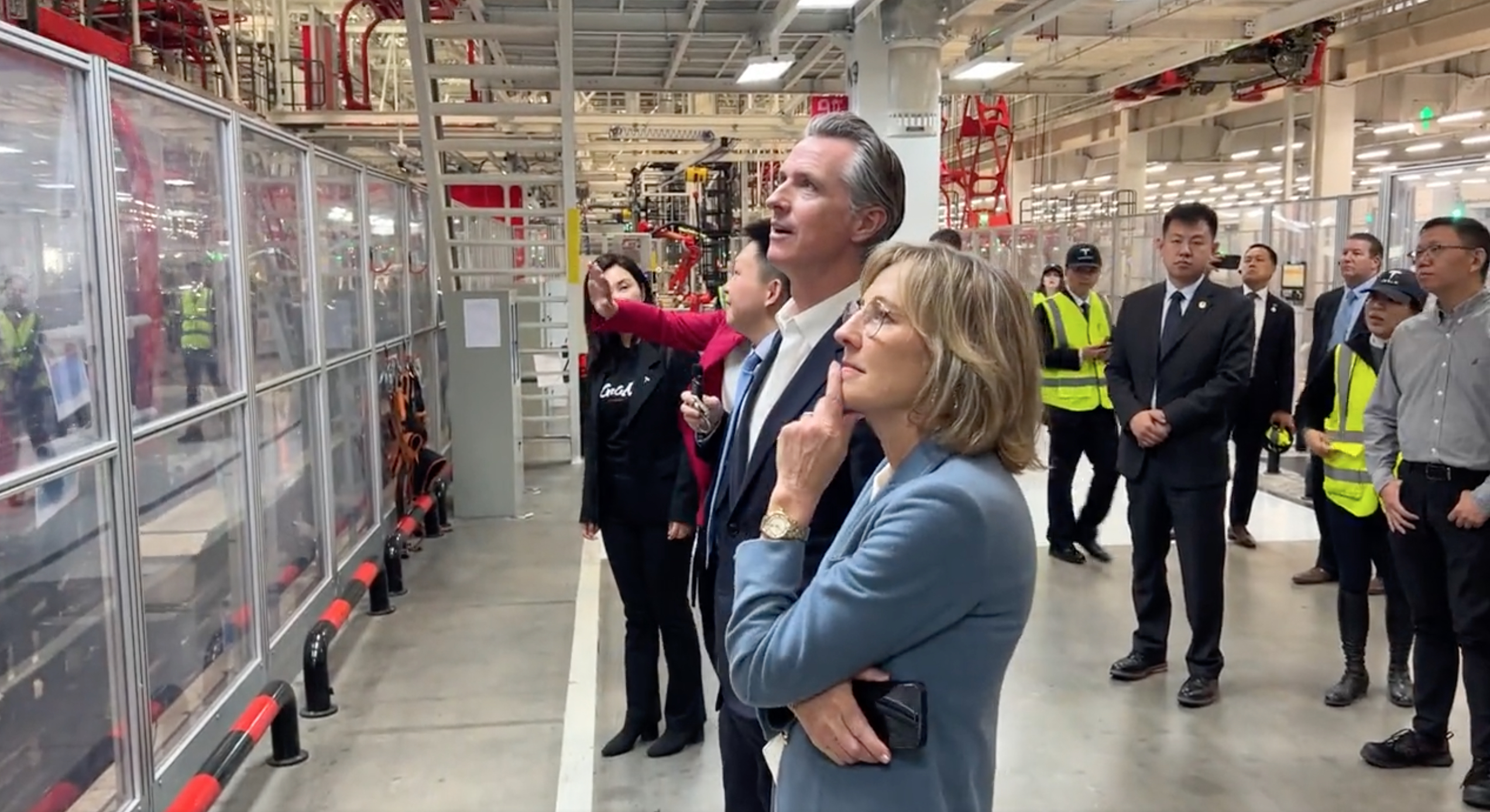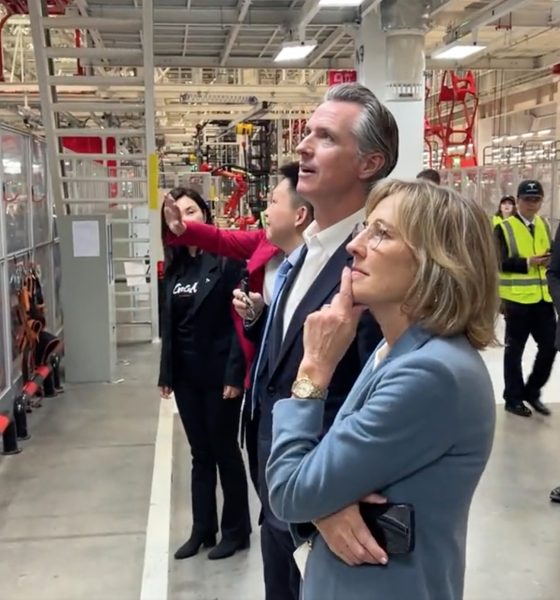California Governor Gavin Newsom is currently visiting China to discuss climate initiatives, and one stop on Sunday included a visit to U.S. automaker Tesla’s factory in Shanghai.
Governor Newsom visited and toured the Tesla Gigafactory in Shanghai on Sunday, as detailed ahead of the trip by Cal Matters and reported by Elex Michaelson in a video on X. The visit to the world’s most productive electric vehicle (EV) plant underscores the unique relationship between the U.S. and China, as the latter country still controls much of the supply chain for EV battery materials.
The visit is intended to look at how China and California can cooperate on climate goals, and it included trips to Shenzen, where a fully electric 16,000-bus fleet is operational, an offshore wind facility in Jiangsu, and finally, the Shanghai facility. In addition, Newsom test-drove one of BYD’s hybrid vehicles and held a meeting in Beijing with Chinese President Xi Jinping.
In the video shared by Michaelson, you can see Newsom and other officials watching as the Model Y production line is in action. Michaelson notes that the facility produces around 2,000 cars per day at Giga Shanghai.
.@GavinNewsom tours @Tesla’s gigafactory outside Shanghai, China.
They produce 2,000 new cars a day here. pic.twitter.com/DE62OyEWKL
— Elex Michaelson (@Elex_Michaelson) October 29, 2023
In a separate video shared on X by WuWa on Sunday, Newsom was asked multiple questions outside of Giga Shanghai, including how he saw Tesla’s role in the cooperation between the U.S. and China.
“It’s demonstrable,” Newsom said. “I mean the jobs it’s created, the entrepreneurial spirit, the innovation. I’m happy to see the success of this facility.”
Newsom was also asked if he would talk to Tesla CEO Elon Musk when he returns to the U.S. about what he saw at Giga Shanghai, responding that he “imagines” they will, and noting that Tesla moved its engineering and R&D headquarters back to California earlier this year, as located in Palo Alto. Tesla also operates a large factory in Fremont, California.
Additionally, Newsom was spotted test-driving Tesla’s newly redesigned Model 3, which you can see below in a video shared by Sawyer Merritt.
California governor Gavin Newsom test drives the new Tesla Model 3pic.twitter.com/khN7Y7UTC6
— Sawyer Merritt (@SawyerMerritt) October 29, 2023
During his time in Jiangsu, Governor Newsom also signed a memorandum of understanding on climate change work, with a particular focus on offshore wind development. The state of California hopes to be producing 25 gigawatts of offshore wind electricity by 2045, which could provide around 13 percent of the state’s power supply and could power roughly 25 million homes in the state.
California has particularly ambitious climate and EV adoption goals compared to many other U.S. states, including a ban on the sale of new gas cars starting in 2035. Although the state has been ahead of the U.S. on EV adoption thus far, China still remains the top miner and producer of EV battery materials.
According to U.K. firm TechInsights, China manages about 80 percent of the world’s cobalt processing, 76 percent of the world’s natural graphite processing, 56 percent of its synthetic graphite and 60 percent of the world’s processing capacity for lithium compounds. The country also produces 50 percent of the world’s sodium hydroxide.
President Joe Biden’s Inflation Reduction Act (IRA) requires at least half of all EV battery components to be sourced in the U.S. or from a country with a free trade agreement.
California to disperse $40.5 million in funding for EV fast-chargers
What are your thoughts? Let me know at zach@teslarati.com, find me on X at @zacharyvisconti, or send your tips to us at tips@teslarati.com.

News
Tesla China delivery centers look packed as 2025 comes to a close
Needless to say, it appears that Tesla China seems intent on ending 2025 on a strong note.

Tesla’s delivery centers in China seem to be absolutely packed as the final days of 2025 wind down, with photos on social media showing delivery locations being filled wall-to-wall with vehicles waiting for their new owners.
Needless to say, it appears that Tesla China seems intent on ending 2025 on a strong note.
Full delivery center hints at year-end demand surge
A recent image from a Chinese delivery center posted by industry watcher @Tslachan on X revealed rows upon rows of freshly prepared Model Y and Model 3 units, some of which were adorned with red bows and teddy bears. Some customers also seem to be looking over their vehicles with Tesla delivery staff.
The images hint at a strong year-end push to clear inventory and deliver as many vehicles as possible. Interestingly enough, several Model Y L vehicles could be seen in the photos, hinting at the demand for the extended wheelbase-six seat variant of the best-selling all-electric crossover.
Strong demand in China
Consumer demand for the Model Y and Model 3 in China seems to be quite notable. This could be inferred from the estimated delivery dates for the Model 3 and Model Y, which have been extended to February 2026 for several variants. Apart from this, the Model Y and Model 3 also continue to rank well in China’s premium EV segment.
From January to November alone, the Model Y took China’s number one spot in the RMB 200,000-RMB 300,000 segment for electric vehicles, selling 359,463 units. The Model 3 sedan took third place, selling 172,392. This is quite impressive considering that both the Model Y and Model 3 are still priced at a premium compared to some of their rivals, such as the Xiaomi SU7 and YU7.
With delivery centers in December being quite busy, it does seem like Tesla China will end the year on a strong note once more.
News
Tesla Giga Berlin draws “red line” over IG Metall union’s 35-hour week demands
Factory manager André Thierig has drawn a “red line” against reducing Giga Berlin’s workweek to 35 hours, while highlighting that Tesla has actually increased its workers’ salaries more substantially than other carmakers in the country.

Tesla Giga Berlin has found itself in a new labor dispute in Germany, where union IG Metall is pushing for adoption of a collective agreement to boost wages and implement changes, such as a 35-hour workweek.
In a comment, Giga Berlin manager André Thierig drew a “red line” against reducing Giga Berlin’s workweek to 35 hours, while highlighting that Tesla has actually increased its workers’ salaries more substantially than other carmakers in the country.
Tesla factory manager’s “red line”
Tesla Germany is expected to hold a works council election in 2026, which André Thierig considers very important. As per the Giga Berlin plant manager, Giga Berlin’s plant expansion plans might be put on hold if the election favors the union. He also spoke against some of the changes that IG Metall is seeking to implement in the factory, like a 35-hour week, as noted in an rbb24 report.
“The discussion about a 35-hour week is a red line for me. We will not cross it,” Theirig said.
“(The election) will determine whether we can continue our successful path in the future in an independent, flexible, and unbureaucratic manner. Personally, I cannot imagine that the decision-makers in the USA will continue to push ahead with the factory expansion if the election results favor IG Metall.”
Giga Berlin’s wage increase
IG Metall district manager Jan Otto told the German news agency DPA that without a collective agreement, Tesla’s wages remain significantly below levels at other German car factories. He noted the company excuses this by referencing its lowest pay grade, but added: “The two lowest pay grades are not even used in car factories.”
In response, Tesla noted that it has raised the wages of Gigafactory Berlin’s workers more than their German competitors. Thierig noted that with a collective agreement, Giga Berlin’s workers would have seen a 2% wage increase this year. But thanks to Tesla not being unionized, Gigafactory Berlin workers were able to receive a 4% increase, as noted in a CarUp report.
“There was a wage increase of 2% this year in the current collective agreement. Because we are in a different economic situation than the industry as a whole, we were able to double the wages – by 4%. Since production started, this corresponds to a wage increase of more than 25% in less than four years,” Thierig stated.
News
Tesla is seeing a lot of momentum from young Koreans in their 20s-30s: report
From January to November, young buyers purchased over 21,000 Teslas, putting it far ahead of fellow imported rivals like BMW and Mercedes-Benz.

Tesla has captured the hearts of South Korea’s 20s-30s demographic, emerging as the group’s top-selling imported car brand in 2025. From January to November, young buyers purchased over 21,000 Teslas, putting it far ahead of fellow imported rivals like BMW and Mercedes-Benz.
Industry experts cited by The Economist attributed this “Tesla frenzy” to fandom culture, where buyers prioritize the brand over traditional car attributes, similar to snapping up the latest iPhone.
Model Y dominates among young buyers
Data from the Korea Imported Automobile Association showed that Tesla sold 21,757 vehicles to the 20s-30s demographic through November, compared to BMW’s 13,666 and Mercedes-Benz’s 6,983. The Model Y led the list overwhelmingly, with variants like the standard and Long Range models topping purchases for both young men and women.
Young men bought around 16,000 Teslas, mostly Model Y (over 15,000 units), followed by Model 3. Young women followed a similar pattern, favoring Model Y (3,888 units) and Model 3 (1,083 units). The Cybertruck saw minimal sales in this group.
The Model Y’s appeal lies in its family-friendly SUV design, 400-500 km range, quick acceleration, and spacious cargo, which is ideal for commuting and leisure. The Model 3, on the other hand, serves as an accessible entry point with lower pricing, which is valuable considering the country’s EV subsidies.
The Tesla boom
Experts described Tesla’s popularity as “fandom culture,” where young buyers embrace the brand despite criticisms from skeptics. Professor Lee Ho-geun called Tesla a “typical early adopter brand,” comparing purchases to iPhones.
Professor Kim Pil-soo noted that young people view Tesla more as a gadget than a car, and they are likely drawn by marketing, subsidies, and perceived value. They also tend to overlook news of numerous recalls, which are mostly over-the-air software updates, and controversies tied to the company.
Tesla’s position as Korea’s top import for 2025 seems secured. As noted by the publication, Tesla’s December sales figures have not been reported yet, but market analysts have suggested that Tesla has all but secured the top spot among the country’s imported cars this year.










